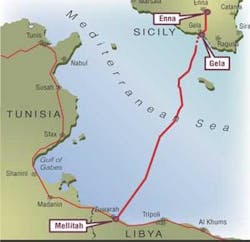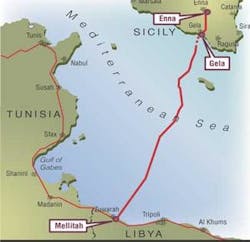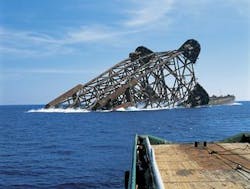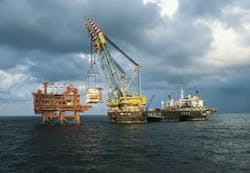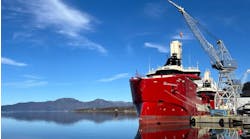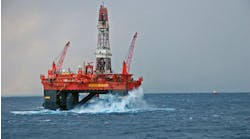Jeremy Beckman
Editor, Europe
Libya’s first gas export scheme is also the Mediterranean’s most ambitious. Partners Eni Gas and Libya’s National Oil Co. (NOC) are investing over $6 billion in developing the Bahr Essalam field 110-km offshore Tripoli and the Wafa field 550-km southwest of the capital.
Gas and condensate from both centers will flow through pipelines to a new processing and compression complex on the coast at Mellitah. Most of the gas will then head north under the sea to Sicily through the newly laid Greenstream trunkline.
Both the length and maximum water depths along the route have set new records for the Mediterranean Sea. Installation of Bahr Essalam’s fixed production platform also involved the world’s heaviest lift of an integrated deck. Keeping the load within the limits of the crane vesselSaipem 7000 was one of the main concerns for engineering, procurement, installation, and commissioning (EPIC) contractor, Saipem. The partners addressed various other organizational and logistical issues in a part of the world under-equipped for offshore activity, due largely to the effects of long-running sanctions.
Long before an end to the embargo, Eni worked on development solutions for Bahr Essalam, located in the 12,000-sq-km offshore block NC41 in the Tripoli-Gabes basin. Periodic drilling on the acreage between 1977 and 1991 revealed 12 significant gas structures. The largest of these, known as C, was a 45 x 5-km elongated anticline trap. According to an Eni presentation in 1995 at the Offshore Mediterranean Conference (OMC) in Ravenna, the reservoir appeared to comprise mainly lower Eocene Nummulitic limestone and dolomite accumulations, both underlain by a tight Mudstone and sealed by a tight Argillaceous limestone. The average gas-bearing interval was around 300-ft thick, with a 25-ft oil leg underlain by an extended lateral aquifer.
Pre-feasibility development studies began in 1991. Eni saw the gas composition of the offshore structures - 13% CO2, 1% H2S, and 5% N2 - as one of the main challenges at that time. Another was how to bring the reserves to both domestic and overseas markets. Eni and NOC investigated harnessing the gas to generate electrical power in southern Europe via a long-distance submarine cable. But the cost and technical risk appeared too great. The same applied to LNG, which at that point was an unknown quantity in northeast Africa.
Libya’s government favored gas exports to Europe via a subsea pipeline. Saipem proved this was feasible in the mid-1990s, when it installed the Transmed lines taking Algerian gas between Tunisia and Sicily. This time around, the probable landfall would be in central southern Sicily, with the route traversing much deeper water. The team devised a solution based on a 32-in. diameter pipeline (considered the technical limit for deepwater S-lay in those days). They also investigated an alternative solution involving two 24-in. lines.
For the main production hub, the team proposed a single platform with a combination of extended-reach wells and subsea completions. The platform would house minimal separation and dehydration facilities.
In summer 1999, the team completed technical evaluations, following a formal agreement between Agip and NOC, on the scope of the Western Libya Gas Project. This would involve producing around 8 tcf of gas and 500 MMbbl of condensate from the Wafa field and the C structure (otherwise known as the Bahr Essalam field). The team agreed to retain around 2 bcm/yr of the gas for the domestic market and export 8 bcm/yr directly to a new reception terminal in Sicily for onward distribution through Italy’s Snam Rete Gas national network.
Technip won a $100 million contract to undertake basic design and front-end engineering for the full range of production facilities, excluding the export line to Sicily. Technip’s brief involved:
•A fixed drilling and production platform with subsea well clusters
• Ten-inch and 36-in. submarine pipelines taking gas and condensate from the platform to Mellitah
• The Mellitah gas/condensate processing plant, 80-km west of Tripoli
•A 30-in./16-in. overland pipeline system conveying gas and condensate from the Wafa field in onshore block NC169 to the same plant
• The Wafa oil and gas treatment plant.
Technip performed the offshore studies from its headquarters in Paris and the onshore portion from its branch in Rome. The company completed its program early in 2001. Around 18 months later, Eni Gas’ Libyan branch, a joint venture between Eni and NOC, awarded the first significant offshore construction assignment. The€581-million turnkey contract for the C structure production platform, now known as Sabratha, went to a consortium of Saipem, as project leader, and Hyundai. The latter would fabricate the 12,000-tonne integrated deck at Ulsan in Korea and procure deck bulk material and half of the equipment. Saipem would handle all other main tasks, namely:
•Detail engineering and procurement of materials (i.e., jacket, pile, and flare steel, and the remaining deck equipment)
• Fabrication of the 24,000-tonne steel jacket by Saipem affiliate Intermare Sarda at its yard in Arbatax, Sardinia
•Fabrication of the 1,700-tonne living quarters module
• Fabrication of the 700-tonne flare
•Installation and mating of both structures, using the crane bargeSaipem 7000
•Hook-up, commissioning, and operational assistance in the early months of production.
Five months later, the team also commissioned Saipem to install all the project’s submarine pipelines. The Greenstream joint venture (Eni 75%, NOC 25%) awarded the contract for the 540-km Libyan Gas Transmission System and the 32-in. trunkline taking processed gas from Mellitah north to the landfall in Gela, Sicily. The 520-km offshore section of this line is the longest and deepest in the Mediterranean Sea, with a maximum water depth of 1,127 m.
For this work, Saipem nominated its lay-bargeCastoro Sei, even though the Saipem 7000 had been its flagship vessel for deepwater trunklines in recent years. Fabio Pallavicini, NC41 C Platform project director, points out that the Castoro Sei also had a strong track record with deepwater pipelay in the 1990s, such as the Transmed and Zeepipe installations. Eni Gas booked the same vessel to lay the two 36-in. and 10-in. pipelines taking gas and condensate from the platform 100-km south to Mellitah. Combined value of these two awards was €685 million.
Around the same time, Saipem’s sister company Snamprogetti gained the€700-million contract to deliver the onshore gas treatment plant, as head of a consortium also comprising ABB Lummus and Hyundai Engineering and Construction. The latter managed construction in Libya. Snamprogetti was responsible for the three gas processing trains, with ABB Lummus handling the sulfur recovery equipment (relating specifically to the offshore input). The plant has a capacity of 6.6 bcm/yr, and is capable of converting product from both fields into sales gas fit for transmission into the Libyan and Italian grids and stabilized condensate for export.
The team awarded the Wafa plant contract (€1.3 billion) to JTS, a consortium made up of JGC, Technimont, and Sofregas.
Field development
The offshore development focus is on three main areas of the C structure - Western, Central, and Eastern - in water depths varying from 140-190 m. Under the current first phase, the team is drilling 14 producer wells from the centrally located platform, some with an extended reach out to 5 km. The team is also drilling 11 wells in the western area from two subsea drill centers. Combined production should peak at around 890 MMcf/d.
Three semisubmersible drilling rigs have been engaged at various stages for this program: the Zagreb1, Bredford Dolphin,and the Sea Explorer. The Sea Explorerhas been retained for completion of all Phase 1 wells, a process that should wrap up by the end of this year. During the second development phase, the team will drill a further 10 subsea wells on the eastern area, along with two subsea wells on the central area. These will not have special sensors or intelligent completions, nor is any form of artificial lift envisioned.An 800-tonne fast-moving workover rig (FMWR) will also be installed on the upper level of the platform’s deck. This will assist in subsea tiebacks and platform well completions and will perform future workover operations. Eiffel in Paris won the engineering and construction contract for this equipment. Its subsidiary in Fos sur Mer, southern France, built the rig.
“The possibility to accommodate tender-assisted drilling has been considered,” Pallavicini adds.
If required, up to five spare well slots could be available. Eni Gas does not anticipate having to bring in an outside rig for subsea well workovers.
A joint venture of Saipem, Doris Engineering, and Cameron designed, engineered, and installed subsea facilities including christmas trees. Rosetti Marino in Ravenna was the subcontractor fabricating the 600-tonne templates and manifolds. Production from the Phase 1 subsea wells will flow through two Inconel-clad 22-in. and 8-in. flowlines to Sabratha, where it will be partly processed along with gas from the platform wells. According to Pallavicini, the main difficulty lies in the fact that gas from the platform wells has a 2% H2S content.
Two three-phase trains will separate the gas before passing through Sabratha’s dehydration module. It should then exit the platform at 70 bar. Two Italian companies, Mangiarotti and Sices, supplied the dehydration columns and the TEG (glycol regeneration) plant. Associated condensate will be flashed on arrival in two stages to 7 bar. Separated water will be further treated prior to disposal, while flashed gas will be compressed to the required delivery pressure, via a low-pressure compressor manufactured by Nuovo Pignone.
Water content in the gas and condensate is carefully controlled, Pallavicini points out, to avoid corrosion in the pipelines. To this end, inhibitors will be injected into the pipelines continuously from the platform. Depending on field performance, a high-pressure compression system could be added within a few years, although simulation studies suggest this is some way off. If required, space is available to accommodate a module weighing up to 1,200 tonnes.
A 140-m-long, 718-metric-ton flare boom on the western end of the top deck level will provide blow-down emergency flaring, if required, at up to 1,270 MMcf/d. Sabratha will also be equipped to receive gas and associated condensate from Agip’s Bouri oifield 20 km away, via a new connecting flowline. The Bouri platform, which started service in the 1980s, recently flared gas at a rate of 100 MMcf/d.
At the onshore end, the Wafa field’s development plan involves drilling 29 new onshore wells (12 light oil and 17 gas) and implementing eight workovers in existing wells. By the end of 2005, both field centers should generate enough gas to meet the committed throughput of 8 bcm/yr in the Greenstream trunkline. Further accumulations within tieback reach of the platform should be onstream within 10 years, according to Domenico Scarcella, Platform Project Manager for Eni Gas BV. If demand from Italy exceeds expectations, there is spare capacity in the pipeline for increased throughput. Libya is known also to have plans for its large undeveloped gas deposits onshore, but there are no plans at this stage to exploit these through a parallel export trunkline to Gela.
Greenstream program
The project team’s first major milestone was completing the Libyan Gas Transmission System (Greenstream) in February 2004. Con- struction of the landfall approaches in Sicily and Libya started in summer 2003. Sub-contractors Sidra and Tideway prepared the 700-m landfall trench at the Italian end, allowing Saipem to pull the pipeline ashore along a cofferdam erected on sand dunes. This proved easier than the approach to Mellitah, where two causeways had to be built and a trench excavated through hard rock to provide access over the coastline for the pipe.
Castoro Seistarted the main pipelay in August that year, with Saipem’s modified laybargeCrawlerinstalling the shore approach sections in Libya. The 516-km offshore section follows a route just to the west of Malta before terminating at Gela on the central section of Sicily’s southern coast. The 50-km long deepwater stretch (800-1,127 m) necessitated some modifications to the Castoro Sei laybarge.
“This program involved reinforcements to anchor racks, increasing the anchor wires’ length and use of 25-tonne capacity pennant buoys for anchor handling operations,” Pallavacini says. “To ensure station-keeping of theCastoro Sei in the deepest waters, a front tug offering 23,000 HP was deployed, giving constant tension. Two 12,000 HP live anchor handling tugs were also employed, along with three further AHTs for anchor movements.”
One of Saipem’s subcontractors, Van Oord Offshore, established a new record when its flexible fall pipe vesselTertnesprotected one of the six cable crossing points in 887 m of water. This beat the previous rock dump depth limit of 820 m, also established in the Mediterranean, just east of Gibraltar on the Maghreb gas trunkline.
The team adopted monitoring systems on this project, first applied to theSaipem 7000 on the Bluestream pipelay operation in the Black Sea, providing real-time feedback on the stress level of the pipe during laying. The trunkline installation was completed in February 2004. Last summer, the Castoro Sei returned to lay the two shorter pipelines between the Sabratha platform and Mellitah, and the flowline from the western subsea cluster to Sabratha.
ASabratha platform
In September 2004, Intermare Sarda completed the 24,000-tonne Sabratha steel jacket in Arbatax and loaded it onto Saipem’s launch barge in preparation for its one-week journey to the project’s offshore site. On arrival, Saipem launched the jacket, which self-upended, then the company connected it to one of theSaipem 7000 cranes. The vessel subsequently ballasted and positioned the jacket over Sabratha’s pre-installed docking piles.
The 202-m-high jacket comprises an eight- legged steel frame below the 35.5-m (underwater) level, switching to a six-legged steel frame up to the 13.5-m section above water, which is mated to the six legs of the single integrated deck. Its dimensions range from 48 x 27 m at the top to 72 x 66 m at the base.
Three months prior to the installation, Saipem commissioned a detailed survey of the seabed location, due partly to concerns over seabed unevenness and the presence of drill cuttings. Saipem planned to check the verticality of the jacket following stabbing of the piles into the pile sleeves. If the outcome did not meet the required tolerance level, measures were in place to apply a leveling tool designed specifically for this application by IHC Handling Systems in The Netherlands (Offshore, August 2004, page 115).
Fortunately, Saipem did not require the new system, although it applied grippers from IHC to the pile sleeves in each corner. TheSaipem 7000 performed piling last fall, driving 16 147-m long piles into the seabed to more than 120 m deep in four clusters, one at each corner of the jacket base.
Due to the sheer size of the jacket and the tight delivery schedule (just over two years from project award), Saipem subcontracted fabrication of items such as the piles, most of the nodes, launch runners, mud mats, pile sleeves, and buoyancy tanks. For logistical reasons, Saipem awarded this work mainly to specialist yards in mainland Italy (in Crotone, Ravenna, La Spezia, and Taranto). One fabricator in Varna, Bulgaria, did contribute buoyancy tanks. German steel mills supplied the plates and tubulars and also welded the legs and bracing, the latter being shipped directly to Arbatax.
Hyundai designed Sabratha’s deck as a single integrated structure to minimize hook-up and to reduce the development schedule. However, there were concerns from the outset that the final weight would exceed 11,700 tonnes, which was close to theSaipem 7000’s lifting capacity, or even a little beyond.
“This was a major issue for the project,” Pallavicini explains. “It meant we had to set up a dedicated committee to constantly monitor the weight as fabrication progressed. Well in advance, we had also formulated a weight-shedding plan, with contingency measures. This would involve removing certain items, if necessary, such as the two TEG regeneration packages and other minor items, and installing them offshore on the deck following the main lift. As part of this monitoring program, we also had to estimate all temporary works on the deck. Once construction had been completed, we performed a final weighing using load cells to confirm that all our assumptions had gone as planned.”
In the event, the deck sailed out of Ulsan on Sept. 28, 2004, weighing 12,100 tonnes, including rigging, having been skidded onto the Dockwise transportation vesselTransshelfusing hydraulic and strand jacks.
On Oct. 30, theTransshelfarrived at the offshore site, following a four-week voyage via the Suez Canal. Two days later, the Saipem 7000 mated the deck to the jacket in a four-hour operation. Certifying authority Lloyd’s Register confirmed the weight as a world record for a single lift offshore. However, Saipem should top its own achievement later this year when the same vessel lifts the Piltun platform topsides into place offshore Sakhalin Island.
In the ensuing weeks, TheCastoro 9 and Viking 2 barges transported the remaining deck modules to the offshore location for subsequent installation by the Saipem 7000. These included the 1,700-tonne, five-level, 110-man living quarters and helideck, the largest assembled to date by Rosetti Marino in Ravenna; the cantilevered flare boom built by Navalmare in La Spezia, and the 800-tonne fast-moving workover rig, which was installed on the platform’s cap beams. This is a stand-alone system with its own power generation and compressed air facilities.
All commissioning of the topsides facilities should be completed by early May. Following tests of the sea lines, production should be ready to start by the end of that month. Saipem will then provide operational assistance through November, under the terms of the EPIC contract. According to Pallavicini and Scarcella’s presentation at OMC Ravenna in 2003, the project can be considered fast-track in that the platform was installed just over two years after contract award.
“Whilst this may be commonplace nowadays,” they stated, “we believe that for a project this size, it is unique within the Mediterranean area.”
